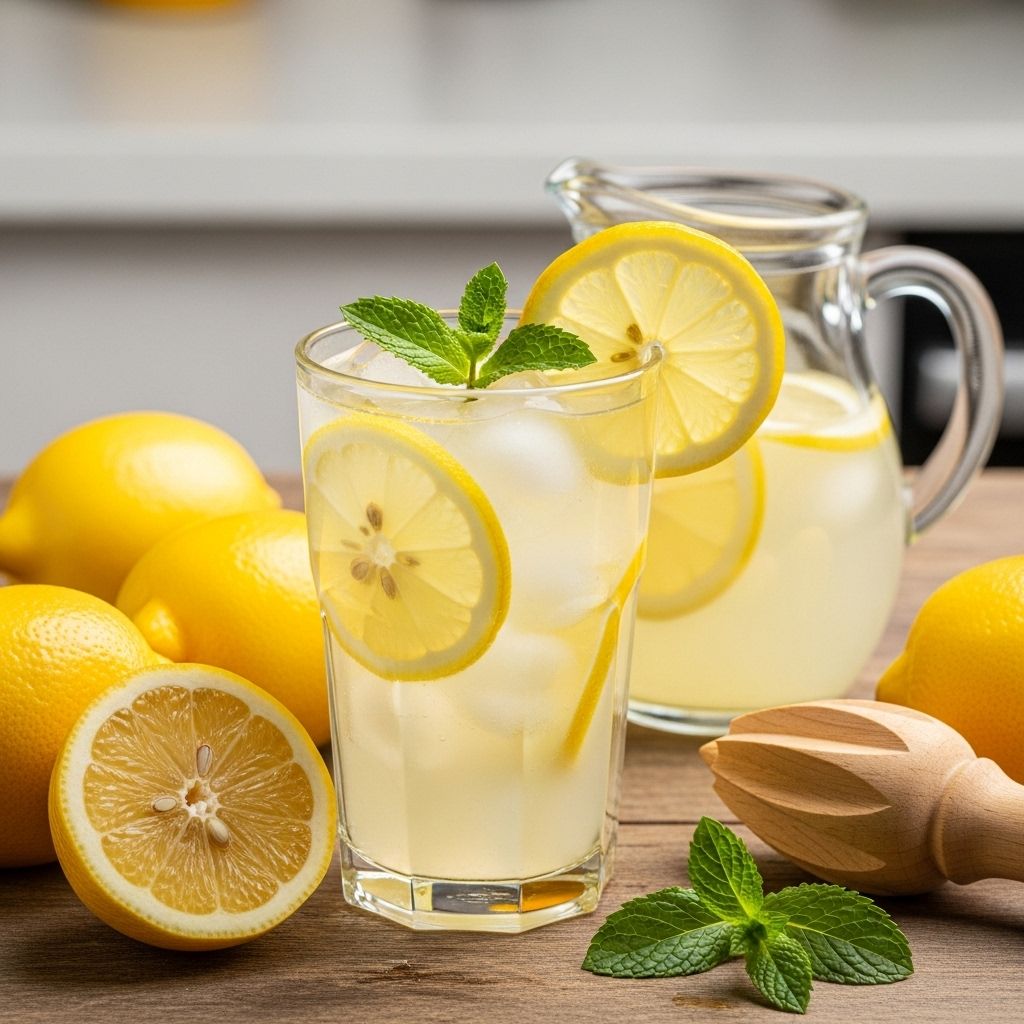Homemade Lemonade Recipe: Ultimate Guide For Perfect Flavor
Master the art of homemade lemonade with expert tips, a classic recipe, serving ideas, and FAQs for the freshest, most refreshing drink.

Image: HearthJunction Design Team
The Best Homemade Lemonade Ever: A Step-by-Step Guide
Is there anything that signals summertime more than a pitcher brimming with ice-cold, sweet-tart lemonade? The following guide will show you exactly how to master homemade lemonade—from the essential ingredients to handy serving and storage tips, and answers to the most common lemonade questions. With a straightforward recipe that’s easy to throw together, you’ll never go back to powdered mixes again.
Why Homemade Lemonade?
Homemade lemonade stands out for its authentic flavor and flexibility. Unlike store-bought or powdered options, making lemonade from scratch lets you control the sweetness and tartness, use real lemon juice, and avoid artificial preservatives. Plus, it’s fast, fun, and incredibly satisfying—perfect for cooling off on a hot day or impressing guests at your next backyard BBQ.
Ingredients for the Best Lemonade
Great lemonade requires just a few staple ingredients you likely already have at home. Here’s what you’ll need:
- Sugar: Granulated white sugar is traditional, but you can experiment with alternatives like honey or agave syrup.
- Water: Both hot (to dissolve sugar) and cold (to dilute the lemon juice) water are necessary.
- Lemon Juice: Freshly squeezed is always best, delivering the most vibrant flavor. Bottled can be used in a pinch.
- Ice: Essential for serving; add just before pouring to avoid diluting your drink.
Ingredient Insights
Sugar and Water: The Secret Simple Syrup
What makes this recipe special is the use of simple syrup. This technique involves dissolving sugar in boiling water, ensuring the finished drink is perfectly smooth and cohesive—no gritty sugar lurking at the bottom of your pitcher. Simple syrup can also be made ahead and refrigerated for use in other beverages.
Lemon Juice: Go Fresh When Possible
While bottled lemon juice will work in a pinch, nothing beats the punch of freshly squeezed lemons. Fresh juice delivers a bright, aromatic flavor. To maximize your juice, roll lemons on the countertop before cutting to break down the membranes, or pop them in the microwave for 10 seconds to enhance juiciness.
Ice: The Cool Factor
The unmistakable refreshment of lemonade comes from serving it ice-cold. Add ice just before serving to prevent dilution, and consider using frozen lemon slices or ice cubes with lemon zest for an extra flair.
Classic Homemade Lemonade Recipe
This easy, fool-proof recipe ensures a perfect balance of sweet and tart. It yields about 8 servings, but can be scaled up or down as needed.
- 1 3/4 cups white sugar
- 8 cups water, divided
- 1 1/2 cups freshly squeezed lemon juice (about 6-8 lemons)
- Ice cubes, for serving
- Lemon slices, for garnish (optional)
Directions
- Make the Simple Syrup: In a small saucepan, combine the sugar with 1 cup of water. Bring to a boil, stirring until the sugar has dissolved completely. Remove from heat, let cool to room temperature, and refrigerate to chill if desired.
- Juice the Lemons: While the syrup cools, squeeze the lemons to yield about 1 1/2 cups of juice. If you like your lemonade with pulp, strain out the seeds but add the pulp back after juicing.
- Assemble the Lemonade: In a large pitcher, combine the chilled simple syrup, lemon juice, and the remaining 7 cups of cold water. Stir well.
- Taste and Adjust: Taste your lemonade and adjust the water, lemon, or syrup for a sweeter or tarter drink.
- Serve: Fill glasses with ice. Pour in lemonade, garnish with lemon slices if desired, and enjoy!
Tips for the Perfect Lemonade
- Customize to Your Liking: Use more or less sugar/water to adjust sweetness or tartness.
- Chill Before Serving: For the best flavor, let your lemonade chill in the refrigerator for at least 30 minutes before serving.
- Infuse Flavors: Add fresh herbs (mint, basil), berries, or ginger for a fun twist.
- Make Lemonade Ice Cubes: Freeze some lemonade in ice cube trays to keep drinks cold without dilution.
- For a Crowd: Easily double or triple the recipe for parties and gatherings.
Serving Suggestions
Lemonade is delicious on its own, but you can take it up a notch with these serving ideas:
- Garnish with fresh herbs such as mint or rosemary for an aromatic twist.
- Float berries (raspberries, blueberries) in the pitcher for color and flavor.
- Rim glasses with sugar—moisten rims with lemon, dip in sugar, then pour lemonade.
- Make lemonade popsicles for a frozen treat.
- Add sparkling water for a fizzy lemonade soda.
Expert Storage Tips
- Refrigerate: Store homemade lemonade in a tightly covered pitcher in the refrigerator. It stays fresh for up to 5-7 days.
- Stir Before Serving: Natural settling may occur—give it a quick stir before pouring.
- Freeze for Later: Lemonade can be frozen in airtight containers for up to 2 months. Thaw in the fridge and stir before serving.
Nutritional Information (Per 8-Ounce Serving)
| Calories | Carbohydrates (g) | Sugar (g) | Vitamin C (%) |
|---|---|---|---|
| 110 | 28 | 25 | Over 50% |
Flavor Variations and Creative Twists
- Pink Lemonade: Add a splash of cranberry or raspberry juice for color and flavor.
- Herbal Lemonade: Infuse the simple syrup with fresh basil, mint, or thyme.
- Lemon-Limeade: Substitute half the lemon juice with lime juice for a tangy blend.
- Spicy Lemonade: Add a few slices of fresh ginger or jalapeño to the pitcher for kick.
- Fruit-Infused: Stir in muddled strawberries, peaches, or watermelon for a fruity upgrade.
Lemonade FAQ
Q: How many lemons do I need for 1 1/2 cups of juice?
A: It typically takes 6–8 medium lemons to yield 1 1/2 cups of fresh juice, depending on size and juiciness. Roll lemons before juicing to extract more liquid.
Q: Can I use bottled lemon juice?
A: Yes, bottled lemon juice can be used in a pinch, but fresh-squeezed will deliver the best taste and fragrance.
Q: How do I make lemonade less sweet or more tart?
A: To reduce sweetness, add more cold water and lemon juice until the desired balance is reached. To sweeten, stir in more simple syrup.
Q: Can I use a sugar substitute?
A: Yes! Substitute the sugar with honey, agave, or a calorie-free sweetener. Adjust quantities to taste, as some substitutes are sweeter than sugar.
Q: How do I keep lemonade cold for an outdoor event?
A: Use plenty of ice, freeze slices of lemon, or make lemonade ice cubes. Consider serving from an insulated dispenser to keep things cool for hours.
Q: What is the best way to juice lemons?
A: A handheld citrus reamer or juicer works well. Squeeze over a mesh strainer to catch seeds, and add pulp back for extra body.
Pro Tips for Lemonade Success
- Balance is Key: The perfect lemonade is a harmony of sweet and tart. Adjust to your taste and remember that chilling often mellows sharp flavors.
- Prep Ahead: Make lemonade a day in advance for deeper flavor integration. Just stir before serving.
- Presentation Matters: A pitcher of lemonade with floating lemon wheels and mint leaves makes for a show-stopping centerpiece.
- Kid-Friendly and Grown-Up Versions: For adults, spike with a splash of vodka, rum, or sparkling wine for a summer cocktail.
Summary: Why You’ll Love This Lemonade
- Simple ingredients and steps make it accessible for every skill level.
- Customizable flavor—adjust sweetness, tartness, or add creative twists.
- Perfect for all occasions, from picnics and BBQs to everyday refreshment.
- Prepare ahead and store easily for convenience and flexibility.
Ready to Refresh?
With just lemons, sugar, water, and ice, you can create the most delicious and refreshing homemade lemonade imaginable. Whether you stick to the classic or add your own creative flair, you’ll have a crowd-pleasing beverage for all occasions. Cheers to simple pleasures and cool sips on warm days!
References
Read full bio of Shinta












